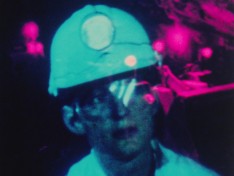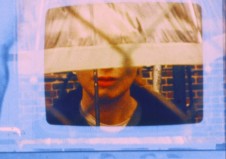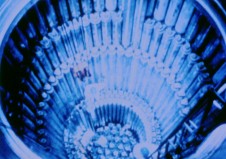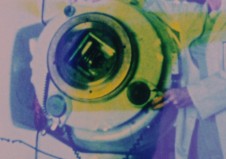Uranium Hex: The Nuclear Films of Sandra Lahire

Uranium Hex (1987)
Uranium Hex: The Nuclear Films of Sandra Lahire
Sunday, July 24, 2022, Doors open at 12:30 pm, showtime at 1:00 pm
At 2220 Arts + Archives, 2220 W. Beverly Blvd., Los Angeles CA
PLEASE NOTE THAT THIS SHOW IS A MATINEE
Tickets: $12 general, $8 students/seniors, free for Filmforum members
At https://link.dice.fm/maedafa47338
Presented for the first time in Los Angeles, URANIUM HEX: THE NUCLEAR FILMS OF SANDRA LAHIRE introduces four important works by the British experimental feminist filmmaker exploring the feminist anti-nuclear, anti-war movement of the 1980's alongside deeply personal narratives of sickness, contamination and corporeal vulnerability of both the self and land.
The program will be introduced by archivist and programmer Charlotte Procter (London, UK) with artist P. Staff (Los Angeles, USA).
Sandra Lahire (1950-2001) was a central figure in the experimental feminist filmmaking community that emerged in the UK in the 1980s. She studied Philosophy at the University of Newcastle-on-Tyne, Fine Art Film at St Martins School of Art (1984) and Film & Environmental Media at the Royal College of Art (1986). She was a dedicated member of the London Film-Makers’ Co-op (now LUX) and feminist film and video distributor Circles (now Cinenova), and her collaborations with other artists were integral to her filmic practice and feminist politics. She utilized the optical printer at the co-op to make stunning 16mm films that explored illness, lesbian identity, the work of Sylvia Plath, environmental concerns, and the anti-nuclear movement. Integral to all her work is the relationship between the body and the materiality of film, registers of violence and proximity to harm. Her films merge documentary, performance, animation, superimposition – both in-camera and via the optical printer.Lahire died in 2001, aged 50, after a prolonged struggle with anorexia. Her loss was felt keenly by her community of friends and collaborators.
Total running time: ca. 85 min.
P. STAFF
P. Staff is an artist based in Los Angeles, USA and London, UK. Staff’s work in video, sculpture and poetry explores the registers of violence that underpin the making of a human subject, interrogating what is at stake in the conditions of queer and trans life. Often citing Sandra Lahire as an influence, their work similarly engages a queer and intertwining notion of affliction and contamination, and similar radioactive, fluorescent palette in their videos and sculptures.
Staff’s notable solo presentations include Serpentine Galleries, UK (2019); MOCA, USA (2017); and Chisenhale Gallery, UK (2015). They have been part of a number of significant group shows, mostly recently the The Milk of Dreams, 59th Venice Biennale (2022); Prelude, LUMA Arles, France (2022); Bodies of Water, the 13th Shanghai Biennial (2021); Made in LA, Hammer Museum (2018); Trigger, New Museum (2017); and the British Art Show 8, touring venues (2016).
CHARLOTTE PROCTER
Charlotte Procter is an archivist, programmer and Collection & Archive Director at LUX, the UK's most significant collection of artists’ moving image. In 2013 she joined the Cinenova Working Group, a collective formed to preserve and distribute the feminist film collection Cinenova. From 2018 to 2021, she co-directed the research project Their Past is Always Present at Elías Querejeta Zine Eskola (San Sebastián, Spain), and she is co-editor of Living on air: the films and words of Sandra Lahire (2021). Recent programmes have taken place at Institut français (UK), British Film Institute (UK), CINEMATEK (BE), Grazer Kunstverein (AT) and Oberhausen Short Film Festival (DE). She continues to work on collaborative projects foregrounding and questioning the historicisation and distribution of feminist & radical media.

Terminals
Terminals
1986, 20 min, 16mm-to-digital
TERMINALS is a stream-of-consciousness collage, which asks us to look at and question the dangers of technological advances and nuclear power.
“The ‘work faster’ ethic is written on the door to the terminals. Hazards to fertility or risks of cancer are not criteria in setting ‘acceptable’ levels of exposure to radiation at work. At the Visual Display Terminal, women are staring directly at a source of radiation.” –Sandra Lahire

Plutonium Blonde
Plutonium Blonde
1987, 16 min, 16mm-to-digital. Recently digitized and restored at Elías Querejeta Zine Eskola (San Sebastian), in the context of the research project “Their Past is Always Present”.
“Part of a trilogy of films on radiation, this dystopic collage frames the fractured narrative of Thelma, a woman working with the monitors in a plutonium reactor. Plutonium blonde, a color reference usually used in beauty products, becomes the reality of the female body in the chemical factory. Through phonic collages of casual conversations and children’s lullabies that are disrupted by the fumes of factories and the threat of a nuclear war, Sandra Lahire’s film confronts the viewer with difficult questions around the damaged bodies that inhabit a chemical reality and the female identity during such a crisis.” –Mariana Sánchez Bueno

Uranium Hex
Uranium Hex
1987, 12 min, 16mm-to-digital
Using a kaleidoscopic array of experimental techniques, this film explores uranium mining in Canada and its destructive effects on both the environment and the women working in the mines. A plethora of images ranging from the women at work to spine-chilling representations of cancerous bodies are accompanied by unnerving industrial sounds and straightforward information from some of the women.

Serpent River
Serpent River
1989, 32 min, 16mm-to-digital
Beautiful but often violent images are interwoven to create an experimental documentary about the hazardous existence of the Serpent River community living in the shadow of uranium mines in Ontario, Canada. SERPENT RIVER is the final part of a trilogy of
anti-nuclear films in which the filmmaker makes visible the invisible menace of radioactivity. People, the landscape, and natural resources all bear the scars.
